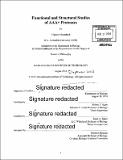Functional and structural studies of AAA+ proteases
Author(s)
Baytshtok, Vladimir
DownloadFull printable version (13.44Mb)
Other Contributors
Massachusetts Institute of Technology. Department of Biology.
Advisor
Robert T. Sauer and Tania A. Baker.
Terms of use
Metadata
Show full item recordAbstract
AAA+ proteases are found in all domains of life. They degrade misfolded proteins as well as specific regulatory factors and thus play critical roles in protein quality control and numerous cellular processes. These enzymes share a conserved architecture in which a hexameric AAA+ ATPase recognizes, unfolds, and translocates substrates into an associated self-compartmentalized peptidase for degradation. In addition to participating in proteolysis, AAA+ ATPases, by themselves, can unfold and/or remodel macromolecular complexes. However, rigorous characterization of these unfolding reactions in the absence of proteolysis has been difficult. In Chapter 2, I develop a robust assay that uses FRET to monitor unfolding of a dimeric substrate. I use this assay to compare and contrast the unfolding activities of the E. coli AAA+ ClpX and ClpA unfoldases, revealing significant functional differences for these enzymes in the presence and absence of ClpP, their cognate peptidase. Substrate recognition is another important aspect of function but is poorly understood for many AAA+ enzymes, including the HslU unfoldase, which partners with the dodecameric HslV peptidase. HslU contains a unique auxiliary domain, called the I domain, which is thought to aid in substrate recognition and to couple ATP hydrolysis to substrate processing. However, the precise mechanism by which the I domain functions remains unclear. In Chapter 3, I use structural and biochemical approaches to characterize a point mutation in the I domain that elevates HslU ATPase activity and alters the preferred direction of substrate unfolding and degradation. These studies shed light on how substrates are recognized and processed by the HslUV protease. In Chapter 4, I develop and use a disulfide-crosslinking approach to generate mixed HslU hexamers containing different numbers and arrangements of hydrolytically active and inactive subunits in an effort to understand how the ATPase cycle of HslU is coupled to function. Contrary to models suggested by the majority of HslUV structures, I find that HslU appears to function using a probabilistic mechanism of ATP hydrolysis.
Description
Thesis: Ph. D., Massachusetts Institute of Technology, Department of Biology, 2016. Cataloged from PDF version of thesis. Includes bibliographical references.
Date issued
2016Department
Massachusetts Institute of Technology. Department of BiologyPublisher
Massachusetts Institute of Technology
Keywords
Biology.